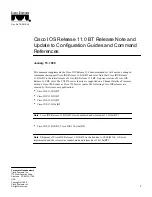
xii
From CX-Designer Version 2.0 to Version 2.1
Item
Previous versions
New version
CX-Designer
Version 2.0
Version 2.1
NS system software
Version 6.6
Version 7.0
Multi-vendor connectivity
---
It is now possible to connect NS-series PTs
to the following devices.
• OMRON Trajexia Motion Controllers
• Yaskawa MP-series Machine Controllers
• Yaskawa F7-series Varispeed and VS
Mini V7-series Machine Controllers
• Mitsubishi Q-series PLCs
NT compatibility
---
System memory can now be allocated to
PLC memory areas in the same way as for
the NT Series, enabling PLC ladder pro-
grams to be easily transferred when migrat-
ing from the NT Series to the NS Series.
Holding previous system mem-
ory values
When an NS-series PT was started, the ini-
tial screen set in the System Setup was
always opened.
It is now possible to display at the next star-
tup the screen that was being displayed
when the program was closed.
Multilingual system capability
The system supported two languages:
English and Japanese.
In addition to English and Japanese, the
system now also supports German,
French, Italian, Spanish, and Chinese (both
traditional and simplified).
Multifunction Objects
Macros were required in order to executed
multiple processes for a single functional
object.
Multifunction Objects have been added to
functional objects.
With Multifunction Object, multiple pro-
cesses can be registered and can then be
executed with the press of a button.
Processes that previously required the cre-
ation of macros can now be executed by
simply setting properties.
Machine Navigator function
Multiple objects, such as frames, labels,
and bitmaps, were used to change displays
such as on-screen characters and BMP
files. Contents of displays were set individ-
ually, which was time-consuming and made
maintenance troublesome.
A Machine Navigator function and a func-
tional object contents display function have
been added. Machine Navigator provides
unified control of text and image files (i.e.,
“contents”) to be displayed, and the new
display function displays those contents.
Contents requiring association can be
managed in ID units, and the display can
be easily changed by simply changing the
ID specification.
Flicker function
The only flicker method for objects was dis-
play color inversion.
The following flicker methods have been
added.
• Display/hide (entire object or label)
• Flicker color specification (fill color, char-
acter, and line colors)
Improved alarm/event sum-
mary and history display
When the history was displayed using the
Alarm/event Summary & History command,
the same alarm/event was displayed in
multiple places for each date of occurrence.
This made it difficult to check the frequency
of occurrence.
In addition, in some cases there were many
items to be displayed and not all of them
could fit on the screen.
A function has been added to provide a
summary of a particular alarm/event on a
single line, making it possible to quickly
check conditions without unnecessary dis-
plays.
A horizontal scrolling function has also
been added to allow all items to be
checked.
Fonts
Raster fonts could be set for objects with
changing display character strings, such as
numeric displays and inputs. Rounded
areas became rough, however, when the
font size was increased.
Scalable fonts have been added to enable
smooth displays. Gothic numeral and 7-
segment displays have also been added to
allow more attractive and up-to-date
screens to be created.
Summary of Contents for NS-CXDC1-V3
Page 1: ...USER S MANUAL Cat No V099 E1 04 NS Series CX Designer Ver 3 NS CXDC1 V3...
Page 2: ......
Page 3: ...CX Designer Ver 3 NS CXDC1 V3 User s Manual Revised April 2009...
Page 4: ...iv...
Page 20: ...xx...
Page 32: ...10 Basic Operation Procedures Section 1 2...
Page 62: ...40 User Interface Section 3 3...
Page 106: ...84 Comparison of Functions with NS Designer Appendix A...
Page 112: ...90 Exchanging Data between NS series Products Appendix C...
Page 114: ...92 Revision History...













































